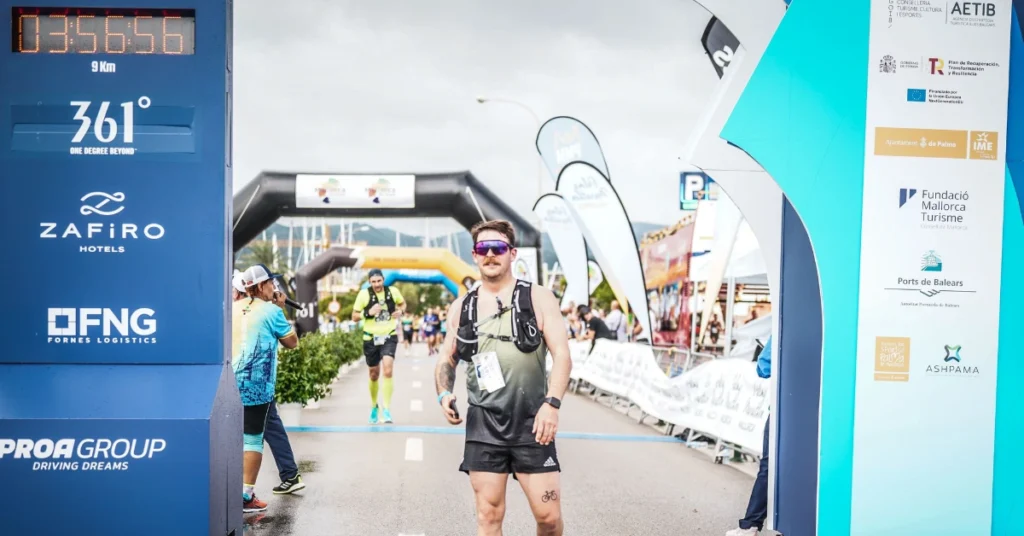Achieving a two-hour finish in a half marathon is a widely sought-after objective for many runners. Covering 13.1 miles or approximately 21.08 kilometers, this milestone requires maintaining a pace of just under 9:09 minutes per mile or 5:41 per kilometer. Training for this target involves not only speed work but also building the stamina to sustain the pace over the distance.
Various strategies and training plans are available to help runners of different levels reach this goal, making it an ideal challenge for both seasoned marathoners and those transitioning from shorter races. Consistent training, proper pacing, and race-day strategy are crucial elements for success in achieving the coveted two-hour finish line.
Pro´s:
- ✅ Enhanced support
- ✅ Breathable material
- ✅ Sufficient padding
Con´s:
- ❌ Length might be too long for certain users
Understanding Half Marathon Pace 2 Hours
When we aim for a half marathon pace 2 hours, we’re committing to a specific, steady pace throughout the 13.1 miles. To hit this goal, we need to maintain an average pace that is both challenging and sustainable from start to finish.
🏃 Breaking Down the 2-Hour Pace
To complete a half marathon in 2 hours, we must adhere to an average pace of 9:09 per mile. This translates to about 5:41 per kilometer if we prefer thinking in metric units. It’s crucial that we focus on maintaining this pace consistently; if we vary too much, we may risk not meeting our target time.

“With the right preparation, it is definitely possible for you to complete your half marathon pace 2 hours! You will notice how quickly you improve if you keep at it.”
📊 Pace Conversion Chart
Here’s a simple conversion chart to help us visualize our pacing:
| Mile Pace | Kilometer Pace |
|---|---|
| 9:09/mile | 5:41/kilometer |
Let’s use it to keep our pace on point as we work towards crossing that finish line in two hours.
Half Marathon Fundamentals

When we approach a half marathon, it’s essential to get familiar with the key metrics and the course layout. Understanding these fundamentals can make all the difference for a successful race day.
📏 Key Metrics of a Half Marathon
A half marathon is 13.1 miles (21.08 kilometers) of both mental and physical challenge. For those of us aiming to finish within 2 hours, it’s crucial that we maintain an average pace of just under 9:09 minutes per mile or 5:41 minutes per kilometer. To achieve this, we must strategize our training to build the necessary stamina and speed.
📍 The Importance of Knowing the Course
Familiarizing ourselves with the course ahead of race day is just as important as our physical preparation. By understanding the course layout, including its elevations and potential weather conditions, we can tailor our training to better simulate the conditions and plan our race strategy. This could mean knowing when to conserve energy and when to pick up the pace.
Training for a Sub-2 Hour Half Marathon
To achieve this, we’ll have to focus on two crucial aspects: building a comprehensive training plan and incorporating effective speed work into our routine.
🏃♂️ Building a Training Plan
Our training plan is the roadmap to race day success. It’s where we lay out weekly mileage that progresses over time, incorporating various types of runs that improve our endurance and speed. A balanced half marathon training plan should typically span 10 to 14 weeks and include:
- Long runs: to build endurance, with the distance gradually increasing each week.
- Tempo runs: to help our bodies get used to sustaining speed over time.
- Easy runs: these should form the bulk of our training, allowing us to recover and add mileage without overstraining.
- Strength training: a critical component that can help prevent injury and improve our overall fitness.
Within our training, we’ll aim for a peak weekly mileage that has us comfortably running enough distance to face the half marathon with confidence but not so much that we risk injury or burnout. For many, this sits between 15-30 miles per week, depending on our experience and current fitness level.
🏃♀️ Incorporating Speed Work
Speed work is our ticket to a faster race day pace. By including interval training and tempo runs in our plan, we’ll improve our ability to sustain our goal pace across the 13.1 miles. Here’s how we can approach it:
- Interval training: These are short, high-intensity bursts of speed followed by a recovery period. For example, we might do 400-meter repeats at a pace quicker than our goal race pace, with a few minutes of jogging or walking to recover in between sets.
- Tempo runs: Different from intervals, these runs are about holding a challenging but manageable pace for a longer period, usually around 20-30 minutes, after a good warm-up.
Incorporating these types of workouts once or twice a week can significantly boost our cardiovascular system’s efficiency, teaching our bodies to handle the lactic acid build-up that occurs at higher intensities. It’s key not to overdo it, though; balance is crucial for avoiding overtraining.
Race Preparation Strategies

To hit a half marathon pace 2 hours, we need to fine-tune our half marathon pacing strategy and prepare both our mind and body for the demands of race day. Let’s focus on developing a consistent race pace and arm ourselves with practical tactics for both physical and mental endurance.
🏃 Developing a Pacing Strategy
To achieve our half marathon pace 2 hours, we must maintain a steady average pace of just under 9:09 minutes per mile. It’s critical to build an aerobic base during training that supports this pace. Crafting a pacing strategy involves understanding our current race times and setting realistic splits.
We might consider planning for a negative split, which entails running the second half of the race faster than the first, ensuring we have energy in reserve to finish strong.
- Example of Pacing Strategy:
- First 5K: Focus on settling into a comfortable rhythm, slight slowdown is acceptable.
- Next 10K: Monitor our pace, aim to be just under our target to build a buffer.
- Final 5.1K: Look to incrementally increase pace for a strong finish.
🧘 Physical and Mental Tactics on Race Day
On race day, our tactics are just as important as our physical preparation. It starts with a good warm-up to signal our body to transition to race mode. Throughout the race, we’ll concentrate on running efficiently and keeping our mind positive. Mental strategies like breaking the race into smaller segments can make the distance feel more manageable.
- Race Day Tips:
- Physical: Keep hydrated, listen to our body, and remember to fuel as practiced.
- Mental: Use affirmations, visualize the finish, and remember why we’re running.
These preparations are our pathway to confidently cross the finish line within our finish time goal.
Nutrition and Hydration Tips

Proper nutrition and hydration are crucial elements in our preparation for a successful half marathon pace 2 hours finish. Let’s dive into the specifics of fueling our training and maintaining energy levels during the race.
🍌 Fueling Your Training Runs
During our training runs, it’s important to experiment with different fueling strategies to find what works best for us. Carbohydrates are our muscles’ main source of energy, and we can maintain our glycogen stores by consuming them regularly. This includes eating a good balance of carbs before, during, and after our runs.
For example, starting our long runs with a breakfast rich in carbohydrates helps set us up for success. Incorporating energy gels or chews approximately every 45 to 60 minutes during the run ensures that we sustain our energy levels throughout.
🏃♀️ Hydration and Energy on Race Day
On race day, staying hydrated is just as important as our fueling strategy. We should aim to hydrate with at least 16 ounces of fluid in the two hours prior to the start. During the race, our goal is to consume 6 to 8 ounces of fluid every 20 minutes, which can be water or sports drinks.
The sports drinks offer the added benefit of replenishing electrolytes and providing quick carbs for energy. Remember, our perceived exertion can increase if we’re not properly hydrated, making the race feel more challenging. It’s best to practice our hydration strategy in training, so we know exactly what works for us on race day.
Additional Training Elements
To run a half marathon pace 2 hours, we need to focus on not just how far or how fast we run. Let’s explore how other training elements like cross-training and recovery, as well as balancing mileage with rest days, can significantly affect our performance and preparedness.
🏋️ Incorporating Cross-Training and Recovery
Cross-training is essential in our training regimen for a well-rounded approach. By introducing activities such as cycling, swimming, or strength training, we engage different muscle groups, which can enhance our running fitness and reduce the risk of injury.
Core work specifically strengthens our midsection, which is pivotal for maintaining good running form, especially as we fatigue late into races. Recovery, on the other hand, is just as critical. We should consider integrating easy days post-hard sessions to allow our bodies the necessary time to heal and adapt.
Recovery might not always mean complete rest—it can be a light jog or a session focused on mobility work.
🛌 Evaluating High Mileage vs. Rest Days
It’s a delicate balance finding the sweet spot between high mileage and sufficient rest days. While building endurance is essential for completing a half marathon in under two hours, it’s also necessary to listen to our bodies and take rest days when needed.
Rest days help prevent overtraining and facilitate muscle repair. We should aim to include rest or easy recovery days in our schedule at least once or twice a week. These off days from running make the hard training days possible and allow us to reap the benefits of hard work without succumbing to burnout or injury.
Advanced Running Techniques

As we look to break the half marathon pace 2 hours barrier, we must incorporate strategic workouts that enhance our speed and endurance. Understanding the balance between various running techniques is critical to achieving our goal.
🏃 Working with Tempo Runs and Long Runs
Tempo runs are essential for teaching our bodies to sustain a faster pace over a considerable distance. Here’s how we can integrate them into our training:
- Tempo Runs: We maintain a comfortably hard pace, one we can hold for at least 20 minutes. This pace improves our lactate threshold, allowing us to run faster without fatigue setting in. For a sub 2-hour half marathon, we aim to keep our tempo run pace around or slightly quicker than our race pace.
- Long Runs: These are crucial for building endurance. Our weekly long run should gradually increase in distance, going up to at least 10-12 miles. It’s not only about the distance but also making sure that the last 3-4 miles of our long runs are at our planned half marathon pace.
🕒 Understanding Split Times and Finish Strategies
We use split times to gauge our pace throughout the race, helping us avoid starting too fast or slowing down unintentionally.
- Mile Repeats: To familiarize ourselves with the race pace, we can perform mile repeats at our desired half marathon pace, aiming for splits that will bring us across the finish line in just under two hours.
- Finish Strategy: We plan for negative splits, running the second half of our race slightly faster than the first. This ensures we finish strong without burning out too early.
By mastering these advanced running techniques, we set ourselves up for success to achieve a half marathon pace 2 hours.
Utilizing Technology and Tools
In our quest to finish a half marathon in less than two hours, we must embrace the technological aids at our disposal. These tools can provide us with real-time feedback, historical data analysis, and personalized pacing strategies that fit our fitness levels.
🏃 The Role of Pace Calculators and Apps
Pace calculators have become indispensable in our planning toolkit. By entering details such as our desired finish time or our recent race times, these calculators instantly provide us with a target running pace to guide our training runs.
For instance, to finish in under two hours, our goal half marathon pace 2 hours needs to be at least 9:09 minutes per mile. Apps like Strava also offer features that monitor our pace in real-time, helping us stay on track during both training and the race itself.
🛰️ Monitoring with Running Watches and GPS
Our running watch is our silent coach, strapped right there on our wrist. These watches leverage GPS to provide accurate pace information and distance covered. They often sync with platforms like Strava, enabling us to analyze every run and share our progress.
More advanced watches can even give us a vibration or audible alert when we deviate from our target pace, making sure we neither burn out too quickly nor lag behind our goal. Having a good quality running watch can literally print out our running blueprint while we’re on the move, making complex calculations look as simple as a Sunday morning jog.
Final Preparations and Race Day Advice

As we approach our goal race day, focusing on our fitness level and solidifying our race strategy for a half marathon pace 2 hours is critical. Let’s lay out our last-minute preparations and race day execution plan to hit that running milestone.
🗓️ The Week of the Race
In the week leading up to the race, we should reduce our mileage considerably to avoid fatigue. Here’s a quick guide:
- Monday to Wednesday: Perform short, easy runs to maintain our fitness level.
- Thursday: Take a rest or do a very light jog to stay loose.
- Friday: Aim to complete a short run with a couple of race pace intervals to keep our goal pace fresh in our muscles.
- Saturday: Rest and hydrate well; perhaps include a brief jog to shake out nerves if feeling restless.
During this week, we also want to ensure our nutrition is on point—carb-loading and staying hydrated are key.
🏁 Race Day Execution
Race Morning:
- Wake up early to eat a familiar pre-race meal. Allow enough time for digestion.
- Check the weather and dress appropriately. Don’t forget to attach your race bib!
Starting Line:
- Warm-up with dynamic stretches and a brief jog.
- Set up our Strava or another tracking device to record our half-marathon PB attempt.
During the Race:
- Start conservatively to avoid going out too fast.
- Stick to our goal race pace and check in with ourselves at each mile marker.
- Follow a fueling strategy, taking carbs on board every 45 to 60 minutes as practiced.
Post-Race:
- After crossing the finish line, initiate a cool down walk and perform static stretches to aid recovery.
- Celebrate our success, whether it’s achieving a sub-2 hour time or simply completing another half marathon!
Our Opinion on Half Marathon Pace 2 Hours


Achieving a half marathon pace 2 hours is a notable goal for many runners, and it requires a blend of speed, endurance, and strategy. We believe that maintaining a steady pace throughout the race is key to crossing the finish line within this time frame.
Pace Breakdown:
- Miles: Aim for a pace just under 9:09 minutes per mile.
- Kilometers: This translates to roughly 5:41 minutes per kilometer.
Remember, consistency is crucial; it’s better to run even splits or a negative split, where the second half of the race is faster than the first. We suggest doing specific workouts that cater to sustaining this pace. Intervals, tempo runs, and long runs should all be part of your training regimen.
Fuel Strategy:
- Hydration: Sip on water or an electrolyte drink to stay hydrated.
- Nutrition: Energy gels or chews can help maintain your glucose levels.
We also recommend simulating race conditions in training to get comfortable with the pace. For beginners, it’s vital to build a solid mileage base before focusing on pace. More experienced runners should consider speed work and strategic race pacing.
FAQ
What is the average pace for a half marathon pace 2 hours?
The average pace for a half marathon pace 2 hours is around 9 minutes and 9 seconds per mile.
What training plan can help me achieve a half marathon pace 2 hours?
A training plan that includes speed work, long runs, and tempo runs can help
improve your pace for a half marathon pace 2 hours.
How can I maintain a consistent pace throughout a 2-hour half marathon?
To maintain a consistent half marathon pace 2 hours, practice pacing during training runs, use a GPS watch, and focus on maintaining a steady effort level.
What is your option on the half marathon pace 2 hours? I would love to hear it in the comments. I’m sure you also like reading about light compression socks for half marathon or our best running shoes for half marathon.



